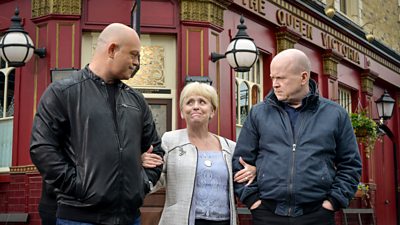Australian soaps may feature the lives of good-looking young people in comfortable suburbs (Neighbours), American soaps the machinations of super-rich Texas oil magnates (Dallas) or Californian wine growers (Dynasty) but when the ����ý One launched its first year-round soap opera, or twice-weekly serial drama, to use the Corporation’s own terminology, viewers zoomed in on February 19th, 1985 to a solidly proletarian square in the East End of London.
First Episode
The opening scene: the local publican, soon to achieve fame and notoriety in equal measure as Dirty Den, accompanied by two neighbours kicks in the door of an old resident to find him slumped, unconscious in his chair, the room, Dickensian in its gloom and seediness. As the others dash off to fetch the local doctor, Arthur stays behind and eyeing a half-empty bottle of whisky by the old man’s side, takes a swig.
This was to be a very different kind of soap opera.
New Times, New Challenges
The programme came out of a changing television ecology. The 1980s were a challenging time for the ����ý, increased competition in the shape of a fourth terrestrial channel, Channel Four and with cable and satellite to come meant that the ����ý faced the prospect of an ever diminishing audience share.
To many it also appeared that the ����ý was losing touch with the public, especially the ����ý One audience and if the Corporation could not attract viewers, then how could it justify the licence fee on which its income depended? This at a time when many of those on the left saw the licence fee as disproportionately burdensome for those on lower incomes, while the government of the day was considering replacing it with advertising.
Preparing the Ground
EastEnders was part of the ����ý’s fight to regain the popular audience. Such a venture would require significant resources, so careful research was conducted as to whether there was an appetite for such a programme and if there was, where should it be set, alongside its Northwest rival Coronation Street or somewhere else?
The research said London, so London it was. In 1984 the ����ý had bought the old ATV studios in Borehamwood and it was here that the EastEnders set was constructed - the programme’s permanent home.
Then there was the question of what kind of programme it would be. For Alan Hart, the Controller of ����ý One when it was commissioned, quality was key.
A Public Service Soap
EastEnders was to be a soap opera, but it was to be a public service soap opera and producer Julia Smith and writer Tony Holland and the small army of scriptwriters who worked on the programme over the years crafted storylines which combined melodrama, multiple plots and (some) humour, deftly interwoven with reference to issues of the day. The opening scene touched on neighbourliness and old age, isolation and poverty, while hinting at problems relating to alcohol. Outside in Albert Square, as people gathered to find out what was going on, racial tensions in this multicultural microcosm were evident.
As it began, so it continued. One early storyline which captured the imagination of viewers centred on the question of teenage pregnancy. Developed over a number of weeks it began with conversations between two young female characters, Sharon and Michelle, about growing up and boys and sex.
Sharon, the more interested of the two, goes to the local GP to ask for advice about contraception. In the event it is the more reluctant of the two who becomes pregnant. Alongside the mystery of who was the father, which played out over a number of weeks a whole raft of related issues were raised and discussed by the characters, from how such matters as contraception, pregnancy outside marriage, abortion etc were dealt with in the past to what would be acceptable now.
This was set against a controversy in the real world, ongoing since 1983, in the courts and in Parliament over whether teenage girls should be able to access contraception and abortion without parental consent.
Criticism and Praise
The programme attracted praise from organisations involved in social issues but also much criticism. Much of the latter found its way into the ����ý Press Log which, on 30 April 1985, recorded moral campaigner Mary Whitehouse as saying, ‘it is one of the worst programmes the ����ý had ever made, a sordid story made in a controversial way simply to increase viewing figures’.
Victoria Gillick, protagonist of the 1983 case was quoted in the Sunday Mirror as saying ‘This soap opera must not treat the matter lightly as if the pill was a sweet,’ and that young girls who slept around acquired a reputation which they later came to regret. Mrs Whitehouse’s National Viewers and Listeners Association and Family Youth Concern called for the Sunday omnibus edition of the programme to be scrapped, a spokesman for the FYC saying ‘It is a tacky soap opera soaked in sexual innuendo and depravity.’
The programme’s makers defended themselves both internally and externally, citing praise from the Council for One Parent Families amongst others and adding that teachers were using the programme as a starting point for discussions of teenage pregnancy but also racism and other issues.
The programme continued in the same fashion, blending the minutiae of the everyday lives of market stall holders, café owners, mechanics, laundrette staff and of course the staff and customers of the Queen Victoria pub with the social concerns of the wider world. It pioneered a gay relationship in 1987, including the in a programme before the watershed.
In 1991, the Boxing Day edition saw returned runaway Mark Fowler tell his parents that he was HIV positive, beginning a long running strand on this topic, again backed up by advice from relevant organisations.
Winning the Audience
What did the audience make of both the programme and its accompanying controversies? Michael Grade, who had taken over as Controller of ����ý One prior to the programme’s launch, answering criticism aimed at him personally, from Mrs Whitehouse (he was to grow accustomed to this) was quoted as saying: "Our most recent research shows that Mrs Whitehouse is out of touch with the sixteen million people watching the programme. It is a highly moral show that places the highest value on the family. The conflicts portrayed arise from the pressures people face trying to keep their families together in the climate of life in 1985".
By the autumn of 1985 along with the huge audience figures, (over 23 million viewers for Boxing Day and 30 million for Christmas Day the following year), the press was full of praise for the programme and Grade was able to state that the fortunes of ����ý One had been restored. Needless to say, [spoiler alert] Dirty Den was the father. Equally needless to mention, EastEnders continues at the heart of ����ý popular programming today.
Written by Dr Anthony McNicholas, University of Westminster
Further reading
Buckingham, D., Public Secrets: EastEnders and Its Audience. (London: BFI 1987)
McNicholas, A, Dr., Wrenching the Machine Around: EastEnders, the ����ý and Institutional Change, Media, Culture and Society, Vol 26(4) (2004)
Smith, J., How to get started - creating a soap opera from scratch in EBU Review Programmes, Administration, Law. Vol. XXXVI, No.6 November (1985)

